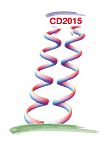Speaker
Simona Giovannella
(INFN-LNF)
Description
The KLOE experiment has collected 2.5 fb-1 at the peak of the phi resonance at the e+e- collider DAPHNE in Frascati.
The V-->Pgamma Dalitz decays, associated to internal conversion of the photon into a lepton pair, are not well described by the Vector Meson Dominance (VMD) models, as in the case of the process omega --> pi0 mu+ mu-, measured by the NA60 collaboration. The only existing data on phi --> eta e+ e- come from the SND experiment, which has measured the Mee invariant mass distribution on the basis of 213 events. At KLOE, a detailed study of this decay has been performed using eta-->pi0pi0pi0 final state. We obtain the measurement of the branching fraction for the process phi --> eta e+ e-, with an accuracy improved by a factor of five with respect to the previous most precise measurement, and the transition form factor, which is in agreement with VMD expectations. We have also studied the decay phi --> pi0 e+ e-, where no data are available on transition form factor. Dedicated analysis cuts strongly reduce the main background component of Bhabha events to ~20%, leading to ~4000 signal events in the whole KLOE data set.
We have also obtained a new, precise results on the isospin-violating decay eta-->pi+pi-pi0, sensitive to the light-quark mass ratio. This study, overcoming in precision previous results published by KLOE in 2008, was suggested by the theoretical work: Leutwyler, Mod.Phys.Lett. A28 (2013) 1360014, aiming to a better determination of the light-quark mass ratio through the dispersive analysis of the eta--> 3 pi decay. The new analysis, performed with an independent and larger data set (1.7 fb-1) and a new analysis scheme and improved Monte Carlo simulation, determines with very good accuracy the parameters of the decay matrix element.
Primary author
Simona Giovannella
(INFN-LNF)

